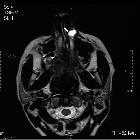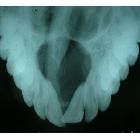Klestadt Cyst






Nasolabial cysts, also known as nasoalveolar cysts or Klestadt cysts, are rare non-odontogenic, soft-tissue, developmental cysts occurring inferior to the nasal alar region.
Epidemiology
Nasolabial cyst occurs 3 times as commonly in women as men. Most patients present in the fourth decade of life.
Clinical presentation
The patient usually presents with a slowly enlarging asymptomatic swelling. Patients usually seek medical advice on secondary infection of the cyst or due to the resulting disfigurement.
On palpation, there is a non-tender, fluctuant, mobile swelling in the alar region. The soft-tissue swelling may obliterate the nasolabial fold, elevate the ala or the floor of the nose (or both) and fill in the labial vestibule intraorally, with or without nasal obstruction. The lesion may spontaneously rupture and drain orally, nasally or, occasionally via a cutaneous fistula.
Pathology
The cyst is derived from epithelial cells retained in the mesenchyme after fusion of the medial and lateral nasal processes and the maxillary prominence during fetal life or due to the persistence of epithelial remnants from the nasolacrimal duct extending between the lateral nasal process and the maxillary prominence.
Radiographic features
The radiographic findings of a cyst in the nasolabial region that is separated from bony structures and teeth is suggestive of a nasolabial cyst.
CT
CT shows a well-demarcated, rounded, homogeneous, low-density soft tissue lesion at the nasolabial region. Evidence of scalloping and bone remodeling may be seen.
MRI
MRI shows the characteristics of fluid in T1 (hypointense) and T2 (hyperintense) sequences.
Treatment and prognosis
Treatment is surgical excision through sublabial incision. There is no tendency for recurrence if it was removed completely. Malignant transformation is rare.
Differential diagnosis
The differential diagnosis should include odontogenic, developmental and neoplastic lesions.
- odontogenic cyst: periapical inflammatory lesion (granuloma, cyst or abscess) that have thinning out the bone; careful examination of the adjacent teeth and testing its vitality can help to rule out this possibility; OPG will show evidence of non-vital tooth with radiolucency
- dentigerous cyst: the usual radiographic appearance of dentigerous cyst is that of a well-demarcated radiolucent lesion attached at an acute angle to the cervical area of an unerupted tooth
- epidermal inclusion cyst: has similar radiographic appearance but pathologically, unlike the normal pink or bluish coloration of a nasolabial cyst, this cyst is a yellow hue in color
See also
Siehe auch:

 Assoziationen und Differentialdiagnosen zu Nasoalveoläre Zyste:
Assoziationen und Differentialdiagnosen zu Nasoalveoläre Zyste:


